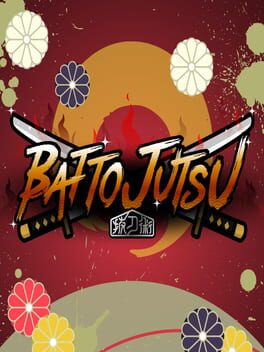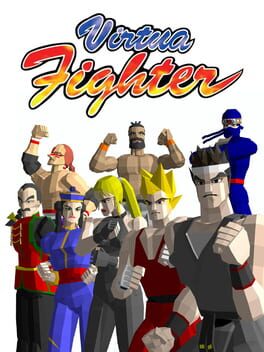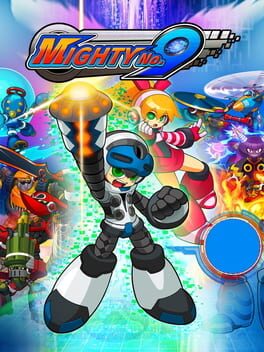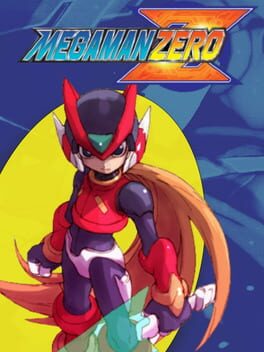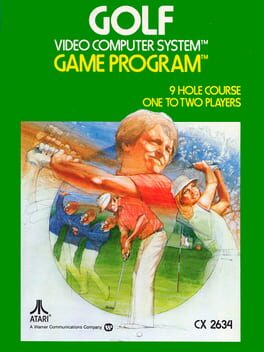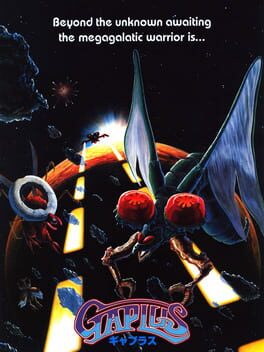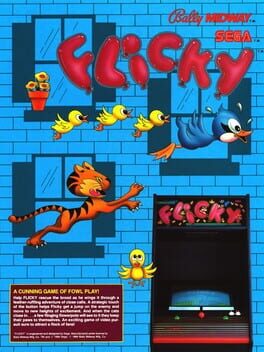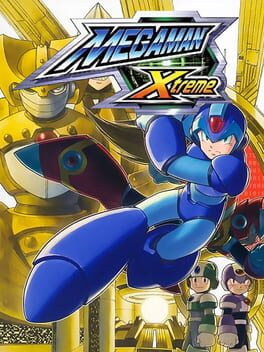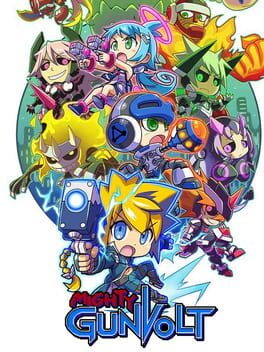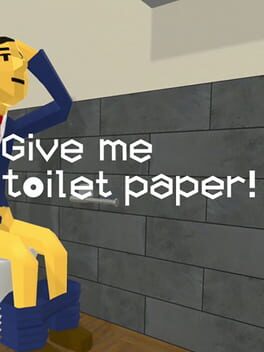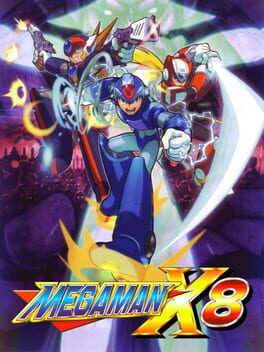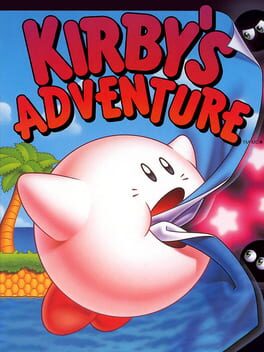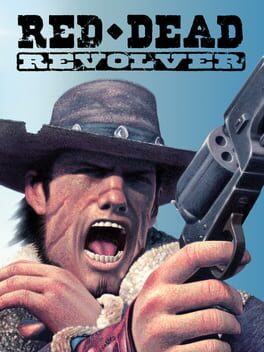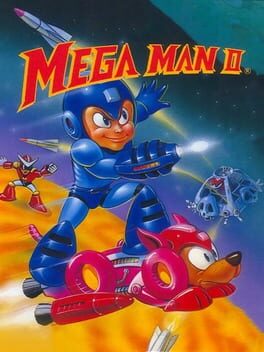PhantomJack
BACKER
2019
Battojutsu is a game I've heard about when Dashie played in one of his Weird Wednesdays videos. It essentially converts the Japanese technique into a simple fighting game where you tap the buttons as fast as you can. It's fun for like a few minutes before it starts to feel repetitive, and it doesn't take long to see everything the game has to offer. I don't like this game that much, but I want to thank Dashie for introducing me to this obscure Switch game.
https://youtu.be/PRXO1IW60W0?si=l2EoA-vBulcvCpOa
https://youtu.be/PRXO1IW60W0?si=l2EoA-vBulcvCpOa
2023
Cel-shaded games have always had a special place in people's hearts. When done correctly, they always have a striking effect on the visuals compared to a modern-day video game and, in some cases, age better than an average AAA game today. Jet Set Radio, while it isn't the first to create the cel-shaded style, revolutionized it by utilizing it appropriately and effectively to create something timeless. I think today, this style is more respected than it was about two decades ago, as developers are employing it in creative ways that give off a distinct look that stands out from the sea of modern gaming. Enter, Hi-Fi Rush, a rhythm-based action game developed by Tango Gameworks and published by Bethesda, took the gaming landscape in shock as it was shadow-dropped on Xbox Series consoles and PC in late January.
You take the role of Chai, a self-proclaimed "rockstar" whose iPod was accidentally fused in his chest during a cybernetic surgery causing him to sense rhythm as the world around him is tied to the beat. After being labeled as a defect by higher-ups of Vandelay Technologies, Chai must stop the company's executives from proceeding with their plans of utilizing SPECTRA as he bands together with new friends that'll assist him on his adventure. It's like Jet Set Radio's plot rebelling against the higher-ups but in a more light-hearted tone. It's a well-paced, well-written story with an enjoyable cast of characters and references that kept me engaged from start to finish.
The gameplay, as I alluded to earlier, combines rhythm and action/adventure genres that culminate into one hell of a unique experience. The world revolves around the beat of Chai's music player, and he takes advantage of that. Chai has a light and a heavy attack, and a dodge for starters; while you can play the game off-key, I think you're doing a disservice to how the game is designed as attacking and dodging to the beat of the track grants increased damage, effects, and a higher rank for each Chorus. Chai can also perform Special Attacks once the gauge is full that can be utilized in battle as they can vary in damaging blows; you'll obtain these in the shop in the hideout or an available monitor in any of the 12 stages. He is also capable of summoning assists, interacting with the environment by aiding Chai with obstacles that he cannot overcome or just breaking barriers and assisting him with combos. All of this in synergy creates immediate satisfaction when pulled off in sync as is Hi-Fi Rush's biggest strengths.
That being said, there are a few things that are holding it back for me from being amazing. The platforming and exploration sequences is one of the more weaker elements of the game as it's clear that combat is its main focus. There's nothing inherently wrong with the platforming itself, it's pretty simple stuff that breaks away from the engaging combat, but it kind of mitigates the pacing a bit. This might be a bit controversial, but I think the music is a jam when listening to it via in combat, but outside of the game, not exactly a huge fan. Now I've played this in Non-Streamer mode, so maybe I'll change my mind when I listen to more of the Streamer soundtrack (and I like a few like The Beacon and My Heart Feels No Pain), but that's how I feel right now.
I had a blast with Hi-Fi Rush. It isn't my 2023 GOTY, but it certainly is refreshing in the vast sea of other AAA games that released this year. I love it when we get games that combines multiple genres into one and get something completely original, and I want more games like this.
You take the role of Chai, a self-proclaimed "rockstar" whose iPod was accidentally fused in his chest during a cybernetic surgery causing him to sense rhythm as the world around him is tied to the beat. After being labeled as a defect by higher-ups of Vandelay Technologies, Chai must stop the company's executives from proceeding with their plans of utilizing SPECTRA as he bands together with new friends that'll assist him on his adventure. It's like Jet Set Radio's plot rebelling against the higher-ups but in a more light-hearted tone. It's a well-paced, well-written story with an enjoyable cast of characters and references that kept me engaged from start to finish.
The gameplay, as I alluded to earlier, combines rhythm and action/adventure genres that culminate into one hell of a unique experience. The world revolves around the beat of Chai's music player, and he takes advantage of that. Chai has a light and a heavy attack, and a dodge for starters; while you can play the game off-key, I think you're doing a disservice to how the game is designed as attacking and dodging to the beat of the track grants increased damage, effects, and a higher rank for each Chorus. Chai can also perform Special Attacks once the gauge is full that can be utilized in battle as they can vary in damaging blows; you'll obtain these in the shop in the hideout or an available monitor in any of the 12 stages. He is also capable of summoning assists, interacting with the environment by aiding Chai with obstacles that he cannot overcome or just breaking barriers and assisting him with combos. All of this in synergy creates immediate satisfaction when pulled off in sync as is Hi-Fi Rush's biggest strengths.
That being said, there are a few things that are holding it back for me from being amazing. The platforming and exploration sequences is one of the more weaker elements of the game as it's clear that combat is its main focus. There's nothing inherently wrong with the platforming itself, it's pretty simple stuff that breaks away from the engaging combat, but it kind of mitigates the pacing a bit. This might be a bit controversial, but I think the music is a jam when listening to it via in combat, but outside of the game, not exactly a huge fan. Now I've played this in Non-Streamer mode, so maybe I'll change my mind when I listen to more of the Streamer soundtrack (and I like a few like The Beacon and My Heart Feels No Pain), but that's how I feel right now.
I had a blast with Hi-Fi Rush. It isn't my 2023 GOTY, but it certainly is refreshing in the vast sea of other AAA games that released this year. I love it when we get games that combines multiple genres into one and get something completely original, and I want more games like this.
1993
Virtua Fighter should be remembered as an influential game, revolutionizing the 3D fighting game genre. But as an actual fighting game, it's fine. It certainly hasn't aged well as the CPUs love to cheat, but I somehow beat it on an actual Sega Saturn with Jacky, that's an accomplishment I guess. Product of its time, but not much besides that.
2016
Kickstarter games can be controversial. For new developers, it's great to resort to crowdfunding, hoping to get the necessary funds to make your game a reality. We've seen some successes before, but sometimes these success stories can spiral down quickly when diving into the meat of development issues and release, causing hype and anticipation that swiftly change to disappointment, and this was no more apparent than with Mighty No. 9. Keiji Inafune's spiritual successor to Mega Man after he departed from Capcom in 2010, and there was a reason to be hyped for it. Being a Mega Man in the early 2010s was bleak after witnessing a multitude of cancellations left to right and was laid dormant for a while, so this was a great opportunity to fill that void. I think most of us know about the Kickstarter debacle, so I'll spare you the details. If you want to learn more about the development history, I'll leave these two links down below.
https://youtu.be/snmGTtyELkQ?si=BPlDbvB084CCYrw3
https://youtu.be/kCIYMPfDQW4?si=jlGh05pE7r2LGI-u
The gameplay is your typical Mega Man fare, you jump and you shoot, and also has a dash, so there's a bit of Mega Man X in there too. What I want to touch on is the new absorption mechanic that was featured in that masterful trailer that Deep Silver squirted out onto YouTube. When an enemy is weakened, Beck can dash into a foe and absorb it, displaying a percentage number on the screen, and can utilize this ability to rack up combos. It is also obligatory to use it on bosses to ransack their health; some are more annoying than others without their proper weaknesses (specifically Mighty No. 1-8) but after some trial and error, they aren't too bad to take down.
The level design is... fine, but it's so boring and basic to traverse through that I don't find any stage in the game to be memorable. They're mostly just straight lines that you can just infinitely dash through (and sometimes break certain areas) to reach the boss room, there's just nothing to it. The stage environments look bland as hell and the same can be said with its presentation. There's something about it that feels cheap and lifeless, and you can probably see the budget cuts. The characters and cutscenes are also uneventful as they revolve around them standing around spewing dialogue and changing expressions without any lip flaps whatsoever or being devoid of personality like Call. That's pretty much all I can say about this game, so I'll wrap this up.
Mighty No. 9 isn't a bad game, it's just not a good spiritual successor to Mega Man, but I think it should be remembered as a cautionary tale to those looking into game development and crowdfunding. This is a prime example of a producer being overly ambitious with its goals and not being able to deliver on all of them. Inafune shot for the moon and instead went down and destroyed the Mighty No. 9 brand, which is a shame.
https://youtu.be/snmGTtyELkQ?si=BPlDbvB084CCYrw3
https://youtu.be/kCIYMPfDQW4?si=jlGh05pE7r2LGI-u
The gameplay is your typical Mega Man fare, you jump and you shoot, and also has a dash, so there's a bit of Mega Man X in there too. What I want to touch on is the new absorption mechanic that was featured in that masterful trailer that Deep Silver squirted out onto YouTube. When an enemy is weakened, Beck can dash into a foe and absorb it, displaying a percentage number on the screen, and can utilize this ability to rack up combos. It is also obligatory to use it on bosses to ransack their health; some are more annoying than others without their proper weaknesses (specifically Mighty No. 1-8) but after some trial and error, they aren't too bad to take down.
The level design is... fine, but it's so boring and basic to traverse through that I don't find any stage in the game to be memorable. They're mostly just straight lines that you can just infinitely dash through (and sometimes break certain areas) to reach the boss room, there's just nothing to it. The stage environments look bland as hell and the same can be said with its presentation. There's something about it that feels cheap and lifeless, and you can probably see the budget cuts. The characters and cutscenes are also uneventful as they revolve around them standing around spewing dialogue and changing expressions without any lip flaps whatsoever or being devoid of personality like Call. That's pretty much all I can say about this game, so I'll wrap this up.
Mighty No. 9 isn't a bad game, it's just not a good spiritual successor to Mega Man, but I think it should be remembered as a cautionary tale to those looking into game development and crowdfunding. This is a prime example of a producer being overly ambitious with its goals and not being able to deliver on all of them. Inafune shot for the moon and instead went down and destroyed the Mighty No. 9 brand, which is a shame.
2002
Prior to Mega Man Zero's release, it's no secret that Keiji Inafune has a fondness for this red and white armored Maverick Hunter ever since the beginning of the X series as a concept of a protagonist before they switched to X. It wasn't until X4 when Zero was given more a spotlight as his campaign was the central focus of the story and was given a "proper" send-off in X5 before Capcom fucked up the timeline with X6 and then ultimately decided to just start the new series. This new sub-series consists of four games released for the Game Boy Advance, but how does the first game hold up in 2023?
Mega Man Zero plays like what you've expected in the X games with a few more weapons at his disposal. There's the Buster Shot, Triple Rod, and Shield Boomerang, but the Z-Saber does the job for me. Striking and slashing enemies down in half feels so damn satisfying, but if you want to have your weapons to the fullest potential, hope you like grinding because you'll be there for an hour if you want to get everything at max level. While I do appreciate the new weapons and they can be utilized in some ways, I don't think they're useful in the long run. All you need is your buster and saber and you're good to go if it's your first time or just challenging yourself to get a high rank.
Speaking of which, Mega Man Zero introduces a ranking system similar to how Devil May Cry functions. Getting a breakneck time with little to no damage and no use of Cyber-elves earns you a high rank and a codename to coincide with. If you're playing Zero 1 blind, you don't need to worry about this as it does not affect the game's pace in any capacity except for a few things, but even those are minuscule. Only do them if you feel like challenging yourself or obtaining achievements. I also don't think the levels are designed with this system in mind as some of these are rough, either due to poor placement or screen crunch. Story-wise I get it; Zero has awakened from his long slumber and you start by being a glass cannon with death coming to you in seconds if you don't plan your actions meticulously. There are some bumps in the road, but once you familiarize yourself, you'll find Zero 1 to be quite engaging with or without some assistance.
I think this is a good segue to talk about the Cyber-elves, a new mechanic added exclusively to the Zero series. They help aid Zero by enhancing his abilities or providing temporary benefits like healing. They'll help you on your journey if you've given them enough Energy Crystals, and I hope you like grinding some more because hoo boy, they demand a lot. Zero 1 also tries to give off an open-world feeling as you can explore the Resistance Base and the levels you've cleared missions on will be opened up to you. While it's cool, it feels undercooked as there is nothing to do besides talking to civilians and farming for Energy Crystals.
Mega Man Zero definitely suffers from First Game Syndrome and it has some rough spots, but besides that I enjoyed my time with it. The story is solid, the gameplay is fun as ever, and I welcome the high challenge. It's inevitable that I'm going to enjoy the following entries more as I like to see the new mechanics get ironed out.
Codename: Buggy
Mega Man Zero plays like what you've expected in the X games with a few more weapons at his disposal. There's the Buster Shot, Triple Rod, and Shield Boomerang, but the Z-Saber does the job for me. Striking and slashing enemies down in half feels so damn satisfying, but if you want to have your weapons to the fullest potential, hope you like grinding because you'll be there for an hour if you want to get everything at max level. While I do appreciate the new weapons and they can be utilized in some ways, I don't think they're useful in the long run. All you need is your buster and saber and you're good to go if it's your first time or just challenging yourself to get a high rank.
Speaking of which, Mega Man Zero introduces a ranking system similar to how Devil May Cry functions. Getting a breakneck time with little to no damage and no use of Cyber-elves earns you a high rank and a codename to coincide with. If you're playing Zero 1 blind, you don't need to worry about this as it does not affect the game's pace in any capacity except for a few things, but even those are minuscule. Only do them if you feel like challenging yourself or obtaining achievements. I also don't think the levels are designed with this system in mind as some of these are rough, either due to poor placement or screen crunch. Story-wise I get it; Zero has awakened from his long slumber and you start by being a glass cannon with death coming to you in seconds if you don't plan your actions meticulously. There are some bumps in the road, but once you familiarize yourself, you'll find Zero 1 to be quite engaging with or without some assistance.
I think this is a good segue to talk about the Cyber-elves, a new mechanic added exclusively to the Zero series. They help aid Zero by enhancing his abilities or providing temporary benefits like healing. They'll help you on your journey if you've given them enough Energy Crystals, and I hope you like grinding some more because hoo boy, they demand a lot. Zero 1 also tries to give off an open-world feeling as you can explore the Resistance Base and the levels you've cleared missions on will be opened up to you. While it's cool, it feels undercooked as there is nothing to do besides talking to civilians and farming for Energy Crystals.
Mega Man Zero definitely suffers from First Game Syndrome and it has some rough spots, but besides that I enjoyed my time with it. The story is solid, the gameplay is fun as ever, and I welcome the high challenge. It's inevitable that I'm going to enjoy the following entries more as I like to see the new mechanics get ironed out.
Codename: Buggy
1980
1984
Gaplus is a fast-paced, frantic sequel to one of my favorite arcade games of all time, Galaga. We have more freedom of movement instead of being restricted only left and right horizontally, there's a bit more variety when it comes to stage types, and using the tractor beam after defeating certain enemies and capturing them to fight on your side is so cool and satisfying to utilize. I've played a little bit on those Multicade machines in local restaurants back in the day, and now after giving it a fair shake via Arcade Archives, this is a good ass time. If you love Galaga, I highly recommend checking this one out.
1984
2000
Capcom is no stranger when it comes to creating handheld experiences of Mega Man games. They've done five games on the original Game Boy so it's kind of a no-brainer that Mega Man X would get the same treatment as well, and what we got was Mega Man Xtreme. It was probably ambitious in 2000, taking the formula of the X series on the go, but in a 2023 lens, it's more a watered-down version of X1 and X2. It plays identically to those two with the only difference being the dash placement options; you either double-tap on the d-pad or use the start button. I'm not a fan of either of these controls, but I went with the 2nd option, and wow this felt cumbersome; I had to readjust my fingers to dash comfortably, but at that point, I rather not have the dash at all. They also do this thing where they split the campaign into two difficulties where you fight the first four Mavericks on Normal and then the second half on Hard. There's also Extreme Mode that has your typical Mega Man X stage select screen with all the eight Mavericks featured from the first two games available at the start, but at that point, I just didn't see a reason to replay it again when I've seen everything the game had to offer.
Mega Man Xtreme is an interesting little game. It's cool seeing these selected stages from X1 and X2 being remade on a tiny handheld shot-by-shot, and while it's inoffensive, it offers little reason to play this in 2023 when the SNES games are readily available on modern systems.
Mega Man Xtreme is an interesting little game. It's cool seeing these selected stages from X1 and X2 being remade on a tiny handheld shot-by-shot, and while it's inoffensive, it offers little reason to play this in 2023 when the SNES games are readily available on modern systems.
2014
Mighty Gunvolt is sort of a spiritual successor to Mega Man 9 and 10 by the same developer, Inti Creates, released coinciding with Azure Striker Gunvolt. It's an okay action 2D platformer; nothing offensive but nothing remarkable. Gunvolt, Ekoro, and Beck are distinct and fun to use, but the stages are the same in their campaigns with little variation. If you're playing it casually, you can clear their campaigns in about an hour if you don't care about the extra levels. If you're a Mega Man fan, this ain't bad if you want something bite-sized, but other than that, nothing special.
The Nintendo Switch is a unique console, that combines the company's past attempts at motion controls and handheld gaming into one. The Joy-Con is the successor to the Wii Remote which implements motion controls without the need for a sensor bar while providing different ways of utilizing it. With the Joy-Cons having that control scheme in mind, it's no surprise that accessories coming from Nintendo or third-party companies will pop up, but what if the accessory was your toilet paper roll? Give Me Toilet Paper answers that question by turning your roll into a controller. To play how it's intended, you're gonna need your left Joy-Con, a toilet paper roll, some tissue paper to hold the Joy-Con in place, and a board capable of some rolling action.
The main objective is to roll your way down to your destination, the random Japanese guy so he can wipe in peace. There are 32 levels to traverse through with new gimmicks and hazards coming along as you progress further on. You tilt your roll left and right as your only means of movement, and if you're playing this game for the first time, I recommend cranking the sensitivity to the max for more freedom of movement. It's a ridiculous concept for a control scheme, but surprisingly, it works. Now to be fair, it's not perfect as I have to keep readjusting my controller and I cheated a little bit by rolling it with my hand to get through a few levels, but for what it is, I think it does a good job of what it's trying to aim for.
Give Me Toilet Paper is fascinating. Taking something as bizarre as inserting a Joy-Con into a roll is utterly fascinating to me and I wish more smaller studios come with more wacky shit like this. If you're interested, pick it up for $5 on the Nintendo eShop.
Also the bgm goes so hard https://youtu.be/g4bgegai-bA
The main objective is to roll your way down to your destination, the random Japanese guy so he can wipe in peace. There are 32 levels to traverse through with new gimmicks and hazards coming along as you progress further on. You tilt your roll left and right as your only means of movement, and if you're playing this game for the first time, I recommend cranking the sensitivity to the max for more freedom of movement. It's a ridiculous concept for a control scheme, but surprisingly, it works. Now to be fair, it's not perfect as I have to keep readjusting my controller and I cheated a little bit by rolling it with my hand to get through a few levels, but for what it is, I think it does a good job of what it's trying to aim for.
Give Me Toilet Paper is fascinating. Taking something as bizarre as inserting a Joy-Con into a roll is utterly fascinating to me and I wish more smaller studios come with more wacky shit like this. If you're interested, pick it up for $5 on the Nintendo eShop.
Also the bgm goes so hard https://youtu.be/g4bgegai-bA
2004
Now this is much better. Mega Man X8 is a return to form after the critical failure that was X7, harkening back to its fundamental 2D routes after a failed execution of converting the popular sub-series into the third dimension, opting for a 2.5D approach to its gameplay. Everything has been given a makeover visually and physically character-wise, and it looks vastly better than what came beforehand. This is one of the more overlooked games in the series, but how does it hold up in 2023 standards? Pretty solid, honestly.
Let's start with the gameplay. What's great about marathoning these sorts of games is that I don't need to reiterate how the game functions when they remain consistent, but I will say that the Maverick Hunters feel so fast and snappy to control that it's genuinely refreshing. The swap mechanic returns after X7, and I've said before in my review that this feature alone makes X, Zero, and Axl feel like a fighting team, and X8 embodies this. Noah's Park, the opening stage, does an excellent job of introducing this mechanic in a 2D space while allowing the player to get a feel for each character. There are moments where character-swapping can be beneficial for situations like getting caught by an enemy and calling in the other character to destroy it with a push of a button. It's just those minor things that make a well-thought-out mechanic even better. X and Zero play identically to how they were in the PS1 games, but for Axl, they made some tweaks like removing the auto-lock on and activating the hover by pressing the jump button twice. Because of that, Axl became one of my favorite characters to use, and with Zero by his side, they were like an unstoppable duo. Bosses now have these desperation attacks whenever their health reaches close to zilch; it's a great way to keep the fights engaging while keeping the players on their toes, so I appreciate that they added a little something to spruce it up without the player exploiting them in designated areas or glitches as an advantage.
For completionists out there, there are these big triangles to collect, aka rare metals. Essentially they unlock certain items that can be obtained from the shop like upgrades and weapons exclusively for Zero. This is a perfect segue to talk about the shop itself, as metals are the only form of currency that can be purchased to buy health upgrades, retry chips, and the stuff I mentioned a sentence ago like Zero's D Glaive for example; this gives you so much range, and once you obtain it, it's over for the common enemies. Heart Tanks have been relegated to Life Up chips you can purchase, making it easier for everyone to have max health bars, so I appreciate that change. These metals are scattered everywhere, where on the ground, defeating enemies, or being rewarded by defeating them fast in certain rooms. There's a lot of shit to collect if you're going for 100%, so you'll be here for a little while.
While I appreciate the amount of stuff you can obtain and purchase, this leads to my major issue with Mega Man X8; it is marred with tedious grinding and can take a few hours to purchase everything. There is one practical way to grind for metals if you're playing it on the Legacy Collection as I did. Go to Metal Valley, pick Axl and another character you like, and keep dashing away from the giant robot until you reach the oil tank wall (where the Light capsule resides), stop there, switch to Ray Gun, and keep firing at the robot until you've collected enough metals. Like I said earlier, this should take about a few hours, and during that time, you might make a grip on your own. Most of the items are reasonably priced if you've bought every upgrade or weapon for the Maverick Hunters, but then come the unlockable characters. Alia, and the two new navigators, Layer and Palette can be unlocked via New Game+ depending on which navigator you used the most. They play identically to how X, Zero, and Axl feel to control and it's cool seeing them in action, but they require an obnoxious amount of metals to even unlock them, 40,000 to be more specific for each, 36,000 if you bought the metal discount from the shop. I was able to unlock them all and obtain 100%, but the few hours I spent out of my 12-hour playtime were spent on grinding. I also find the level design to be cheap at times. It's not X6 levels of cheapness, far from it (the levels are decently designed), there are a few areas in the game that I found either frustrating or nerve-wracking like the literal spike fest in the final levels where you have to be cautious of your jumps and air-dashing; Booster Forest (Bamboo Pandamonium's stage) has that aggravating rare metal placement where I have to flip-flop between getting on and off the ride armor just to press some switches; mess it up, and you have to start the stage all over again. But I think the worst level in the entire game in my opinion is Central White (Avalanche Yeti's stage); a ride chaser level with a length that feels like it goes on for an eternity. Checkpoints are scarce here meaning if you die on the second fight of the mid-boss, you start halfway again. This goes on for like 6-7 minutes if you don't die once and keep X alive to obtain the light capsule.
The story itself is alright for Mega Man X standards. A big step up from X7 that's for sure, but I wouldn't say it's well-written. Sigma returns (obviously) alongside the creator of the Jakob Project, Lumine. They try to do this thing where the big bad from seven consecutive games isn't the final boss this time and instead, it was another individual holding the reins, which I sensed coming from a mile away. Even with its antagonists, I just wish they would illustrate it better with who's controlling who and their motivations, but other than that, it's your typical Mega Man X story. I'm happy to say for the first time in an X game, it has decent English voice acting. Everyone in X8 carries with their performances and it makes the poorly written story tolerable to the ears. X, Zero, and Axl feel like they belong together as a team instead of being conflicted with each other like in X7, and I'm glad they shifted X's personality back to how he was pre-X7, claiming his titular spot once again with the other two at his presence.
The music in X8 is genuinely underrated. There's a whole lot of electric guitars in the soundtrack and I do quite like it. I'm just gonna skim through my favorites before I wrap things up. Vs. Vile is the best theme our familiar rival has, and it feels so tailor-made for a recurring sworn enemy like Vile. Central White (Avalance Yeti's Stage) has got to be my favorite ice-themed stage as that bass was slappin' so hard, perfect for something like a high-speed ride chaser level. Gateway is a beautiful song; it deviates from the electric guitars in favor of something melancholic and relaxing to the ears before our fellow Maverick Hunters take on the Mavericks once more till they reach their destination. Vs. Lumine - Second Form has got to be one of my favorite final boss themes from a Mega Man game; it's as if the lyrics from the Bible were replaced with electric guitars blaring in the background while our heroes take on one last battle.
Mega Man X8 is a huge step up from before and is one of the more overlooked Mega Man games, and of course I say this as this was the lowest-selling game in the franchise. Sadly, X7 tainted the legacy of the series due to the decline in quality not to mention the overabundance of games that Capcom released in the early to mid-2000s, which is a shame really. It is by no means my favorite, but as the last mainline game in the series so far, I think it ended on a good note. I hope that Capcom recognizes the potential of this franchise once again after the recent Legacy Collections have been financially doing well lately, and I hope we get an actual conclusion to the X series with X9 if that ever happens someday.
Let's start with the gameplay. What's great about marathoning these sorts of games is that I don't need to reiterate how the game functions when they remain consistent, but I will say that the Maverick Hunters feel so fast and snappy to control that it's genuinely refreshing. The swap mechanic returns after X7, and I've said before in my review that this feature alone makes X, Zero, and Axl feel like a fighting team, and X8 embodies this. Noah's Park, the opening stage, does an excellent job of introducing this mechanic in a 2D space while allowing the player to get a feel for each character. There are moments where character-swapping can be beneficial for situations like getting caught by an enemy and calling in the other character to destroy it with a push of a button. It's just those minor things that make a well-thought-out mechanic even better. X and Zero play identically to how they were in the PS1 games, but for Axl, they made some tweaks like removing the auto-lock on and activating the hover by pressing the jump button twice. Because of that, Axl became one of my favorite characters to use, and with Zero by his side, they were like an unstoppable duo. Bosses now have these desperation attacks whenever their health reaches close to zilch; it's a great way to keep the fights engaging while keeping the players on their toes, so I appreciate that they added a little something to spruce it up without the player exploiting them in designated areas or glitches as an advantage.
For completionists out there, there are these big triangles to collect, aka rare metals. Essentially they unlock certain items that can be obtained from the shop like upgrades and weapons exclusively for Zero. This is a perfect segue to talk about the shop itself, as metals are the only form of currency that can be purchased to buy health upgrades, retry chips, and the stuff I mentioned a sentence ago like Zero's D Glaive for example; this gives you so much range, and once you obtain it, it's over for the common enemies. Heart Tanks have been relegated to Life Up chips you can purchase, making it easier for everyone to have max health bars, so I appreciate that change. These metals are scattered everywhere, where on the ground, defeating enemies, or being rewarded by defeating them fast in certain rooms. There's a lot of shit to collect if you're going for 100%, so you'll be here for a little while.
While I appreciate the amount of stuff you can obtain and purchase, this leads to my major issue with Mega Man X8; it is marred with tedious grinding and can take a few hours to purchase everything. There is one practical way to grind for metals if you're playing it on the Legacy Collection as I did. Go to Metal Valley, pick Axl and another character you like, and keep dashing away from the giant robot until you reach the oil tank wall (where the Light capsule resides), stop there, switch to Ray Gun, and keep firing at the robot until you've collected enough metals. Like I said earlier, this should take about a few hours, and during that time, you might make a grip on your own. Most of the items are reasonably priced if you've bought every upgrade or weapon for the Maverick Hunters, but then come the unlockable characters. Alia, and the two new navigators, Layer and Palette can be unlocked via New Game+ depending on which navigator you used the most. They play identically to how X, Zero, and Axl feel to control and it's cool seeing them in action, but they require an obnoxious amount of metals to even unlock them, 40,000 to be more specific for each, 36,000 if you bought the metal discount from the shop. I was able to unlock them all and obtain 100%, but the few hours I spent out of my 12-hour playtime were spent on grinding. I also find the level design to be cheap at times. It's not X6 levels of cheapness, far from it (the levels are decently designed), there are a few areas in the game that I found either frustrating or nerve-wracking like the literal spike fest in the final levels where you have to be cautious of your jumps and air-dashing; Booster Forest (Bamboo Pandamonium's stage) has that aggravating rare metal placement where I have to flip-flop between getting on and off the ride armor just to press some switches; mess it up, and you have to start the stage all over again. But I think the worst level in the entire game in my opinion is Central White (Avalanche Yeti's stage); a ride chaser level with a length that feels like it goes on for an eternity. Checkpoints are scarce here meaning if you die on the second fight of the mid-boss, you start halfway again. This goes on for like 6-7 minutes if you don't die once and keep X alive to obtain the light capsule.
The story itself is alright for Mega Man X standards. A big step up from X7 that's for sure, but I wouldn't say it's well-written. Sigma returns (obviously) alongside the creator of the Jakob Project, Lumine. They try to do this thing where the big bad from seven consecutive games isn't the final boss this time and instead, it was another individual holding the reins, which I sensed coming from a mile away. Even with its antagonists, I just wish they would illustrate it better with who's controlling who and their motivations, but other than that, it's your typical Mega Man X story. I'm happy to say for the first time in an X game, it has decent English voice acting. Everyone in X8 carries with their performances and it makes the poorly written story tolerable to the ears. X, Zero, and Axl feel like they belong together as a team instead of being conflicted with each other like in X7, and I'm glad they shifted X's personality back to how he was pre-X7, claiming his titular spot once again with the other two at his presence.
The music in X8 is genuinely underrated. There's a whole lot of electric guitars in the soundtrack and I do quite like it. I'm just gonna skim through my favorites before I wrap things up. Vs. Vile is the best theme our familiar rival has, and it feels so tailor-made for a recurring sworn enemy like Vile. Central White (Avalance Yeti's Stage) has got to be my favorite ice-themed stage as that bass was slappin' so hard, perfect for something like a high-speed ride chaser level. Gateway is a beautiful song; it deviates from the electric guitars in favor of something melancholic and relaxing to the ears before our fellow Maverick Hunters take on the Mavericks once more till they reach their destination. Vs. Lumine - Second Form has got to be one of my favorite final boss themes from a Mega Man game; it's as if the lyrics from the Bible were replaced with electric guitars blaring in the background while our heroes take on one last battle.
Mega Man X8 is a huge step up from before and is one of the more overlooked Mega Man games, and of course I say this as this was the lowest-selling game in the franchise. Sadly, X7 tainted the legacy of the series due to the decline in quality not to mention the overabundance of games that Capcom released in the early to mid-2000s, which is a shame really. It is by no means my favorite, but as the last mainline game in the series so far, I think it ended on a good note. I hope that Capcom recognizes the potential of this franchise once again after the recent Legacy Collections have been financially doing well lately, and I hope we get an actual conclusion to the X series with X9 if that ever happens someday.
1993
Kirby's Adventure surprised me with how it was able to run this massive colorful and vibrant game onto an NES. It is one hell of a showcase when it comes to the system itself, and what it delivered was a fun and engaging experience at the cost of a smooth frame rate. This is the obvious downside of Kirby's Adventure as the frame rate chugs on certain occasions due to how huge the game is. It's manageable as it doesn't interfere with my enjoyment of the game, but it’s heavily noticeable.
Copy abilities made their debut here as they laid the foundation for future installments. Not all of these abilities are winners, I mean the Light ability exists with its only purpose being to light up dark rooms (exciting I know), but the rest are fun to utilize. Kirby's Adventure remains consequential in the franchise's history and is easily a Top 5 for me when it comes to the NES' library. Check this one out if you haven't.
Copy abilities made their debut here as they laid the foundation for future installments. Not all of these abilities are winners, I mean the Light ability exists with its only purpose being to light up dark rooms (exciting I know), but the rest are fun to utilize. Kirby's Adventure remains consequential in the franchise's history and is easily a Top 5 for me when it comes to the NES' library. Check this one out if you haven't.
2004
Storytime, when I was getting out of my comfort zone by playing non-Nintendo games when I received an Xbox One X back in 2018, opened the door to new experiences, and one of those experiences I dived into at the time was Red Dead Redemption. With its engaging gameplay, rich setting, and complex narratives, I ended up loving the duology and were my complete introduction to Rockstar Games. With that said, I've always been fascinated with Red Dead Revolver after relishing my time in RDR as I've seen images and a few videos of the game itself, but never played it until this year. Before I delve into the game itself, Red Dead Revolver has a fascinating development history.
The game was originally produced by Capcom with Angel Studios as the developer, acting as a spiritual successor to the 1985 arcade game, Gun.Smoke. This incarnation of Red Dead Revolver was planned to be released in 2002, but due to rocky development, it rarely saw the light of day. However, it caught the attention of Rockstar Games as it had potential in their eyes, and in 2002, their parent company, Take-Two Interactive bought the studio for $28 million and renamed it to Rockstar San Diego. This was the game's redemption at proceeding with the development with the game's release in May 2004 for the PlayStation 2 and Xbox. If you want to learn more about the history, I recommend the links below.
https://youtu.be/zxVewjwwhog
https://sea.ign.com/red-dead-revolver-ps4/171557/news/how-rockstar-games-redeemed-red-dead-revolver-into-a-successful-franchise
Red Dead Revolver has you taking the reins of Red Harlow. After witnessing the murder of his parents, Red sets out on a journey seeking revenge on the person who killed his loved ones. Along the way, you'll meet some faces like Jack Swift and Annie Stoakes who will accompany you and serve as playable characters in their respective chapters. The story is pretty basic, and the characters are all two-dimensional, but it has that Rockstar feels that I loved in the later entries, and it was enough to engage me the whole way through.
Red Dead Revolver is an arcade third-person shooter with missions to complete and bounties to hunt. In between missions, you can explore the small hub world called Brimstone with people to interact with, weapons to purchase, and other stuff to buy that serves zero purpose outside of filling your journal. The Dead Eye mechanic made its debut in Red Dead Revolver, and essentially what it does is slow down time, opening up the chance to send a flurry of bullets to your enemies. For 2004 standards, I think it functions decently, though I found it to be more effective when being up close rather than far away. Speaking of which, some of the enemies in this game (specifically bosses) are essentially bullet sponges who take so many shots to kill. Adding on to a lack of health items and checkpoints can make certain stages feel unfair. Stage 25 is the worst example of this as near the end of the level, I had to protect one of my allies from waves of enemies while he was opening the door, and death can come by at any minute if I'm not careful. All of that culminates into one big shitshow of a level, and particular levels like these infuriate me when playing through this blind.
Overall, Red Dead Revolver is a decent third-person shooter. It has some rough edges for sure, but there's a bit of fun here to justify that. I don't think I see myself replaying this one in the foreseeable future, but I think it serves as a consequential piece of Rockstar's legacy. Without Red Dead Revolver, we would've never received the critically acclaimed Red Dead Redemption titles that gave us a full taste of what an open-world Western game can be.
The game was originally produced by Capcom with Angel Studios as the developer, acting as a spiritual successor to the 1985 arcade game, Gun.Smoke. This incarnation of Red Dead Revolver was planned to be released in 2002, but due to rocky development, it rarely saw the light of day. However, it caught the attention of Rockstar Games as it had potential in their eyes, and in 2002, their parent company, Take-Two Interactive bought the studio for $28 million and renamed it to Rockstar San Diego. This was the game's redemption at proceeding with the development with the game's release in May 2004 for the PlayStation 2 and Xbox. If you want to learn more about the history, I recommend the links below.
https://youtu.be/zxVewjwwhog
https://sea.ign.com/red-dead-revolver-ps4/171557/news/how-rockstar-games-redeemed-red-dead-revolver-into-a-successful-franchise
Red Dead Revolver has you taking the reins of Red Harlow. After witnessing the murder of his parents, Red sets out on a journey seeking revenge on the person who killed his loved ones. Along the way, you'll meet some faces like Jack Swift and Annie Stoakes who will accompany you and serve as playable characters in their respective chapters. The story is pretty basic, and the characters are all two-dimensional, but it has that Rockstar feels that I loved in the later entries, and it was enough to engage me the whole way through.
Red Dead Revolver is an arcade third-person shooter with missions to complete and bounties to hunt. In between missions, you can explore the small hub world called Brimstone with people to interact with, weapons to purchase, and other stuff to buy that serves zero purpose outside of filling your journal. The Dead Eye mechanic made its debut in Red Dead Revolver, and essentially what it does is slow down time, opening up the chance to send a flurry of bullets to your enemies. For 2004 standards, I think it functions decently, though I found it to be more effective when being up close rather than far away. Speaking of which, some of the enemies in this game (specifically bosses) are essentially bullet sponges who take so many shots to kill. Adding on to a lack of health items and checkpoints can make certain stages feel unfair. Stage 25 is the worst example of this as near the end of the level, I had to protect one of my allies from waves of enemies while he was opening the door, and death can come by at any minute if I'm not careful. All of that culminates into one big shitshow of a level, and particular levels like these infuriate me when playing through this blind.
Overall, Red Dead Revolver is a decent third-person shooter. It has some rough edges for sure, but there's a bit of fun here to justify that. I don't think I see myself replaying this one in the foreseeable future, but I think it serves as a consequential piece of Rockstar's legacy. Without Red Dead Revolver, we would've never received the critically acclaimed Red Dead Redemption titles that gave us a full taste of what an open-world Western game can be.
1991
With Dr. Wily's Revenge being a successful jump to the Game Boy, it's no secret that sequels were greenlit. But instead of the original devs returning to make the sequel exist, they hire someone else who is inexperienced with the franchise itself. Mega Man II on Game Boy is just that with Biox working sequel instead of Minakuchi Engineering, and usually with new developers at the helm, there are always going to be some changes that don't quite capture the magic of what makes the predecessors special, and in the case for this game, the difficulty. This is the easiest Mega Man game I've experienced, and I've only played about 20+ games thus far if we're counting the sub-series. This is a big departure from what came beforehand as once was a decent challenge with a ridiculous difficulty spike near the end of the first game is now a cakewalk from start to finish in the second game. Also the music takes a hit, it doesn't sound as pleasant to the ears as it was with Dr. Wily's Revenge. I've heard worse, but it’s very noticeable when experiencing it for the first time. The naming is also atrocious as it's called Mega Man II (NA and EU), not to be confused with Mega Man 2, contrary to how it was called in Japan as Rockman World 2. It would've made perfect sense to tell the difference overseas, but no, Roman numerals would help.
It includes the four Robot Masters from Mega Man 2 (NES) with the final four coming from Mega Man 3 (NES) in the latter half of the game. It's the same as Dr. Wily's Revenge structure-wise with Robot Masters to destroy, and encounter a new foe that is exclusive to the handheld games, this time being Quint; a Mega Man from the future... that is on what seems to be a combination of a pogo stick and a jackhammer (riveting I know). Obtain the special weapon that is only used for fighting Dr. Wily, and then credits. There isn't much for me to say here, so I'll wrap things up.
Mega Man II on the Game Boy in my opinion is a slight improvement compared to its first Game Boy outing. Yeah, the challenge is almost non-existent, but at least it's consistent which I can't say the same with Dr. Wily's Revenge. Even though I had a slightly better time with the sequel, this isn't something I want to replay in the near future.
It includes the four Robot Masters from Mega Man 2 (NES) with the final four coming from Mega Man 3 (NES) in the latter half of the game. It's the same as Dr. Wily's Revenge structure-wise with Robot Masters to destroy, and encounter a new foe that is exclusive to the handheld games, this time being Quint; a Mega Man from the future... that is on what seems to be a combination of a pogo stick and a jackhammer (riveting I know). Obtain the special weapon that is only used for fighting Dr. Wily, and then credits. There isn't much for me to say here, so I'll wrap things up.
Mega Man II on the Game Boy in my opinion is a slight improvement compared to its first Game Boy outing. Yeah, the challenge is almost non-existent, but at least it's consistent which I can't say the same with Dr. Wily's Revenge. Even though I had a slightly better time with the sequel, this isn't something I want to replay in the near future.
